Business
US wheat, corn and oats closed higher last week
Sub-freezing temperatures drove the US wheat markets while demand remains strong for oats and corn.
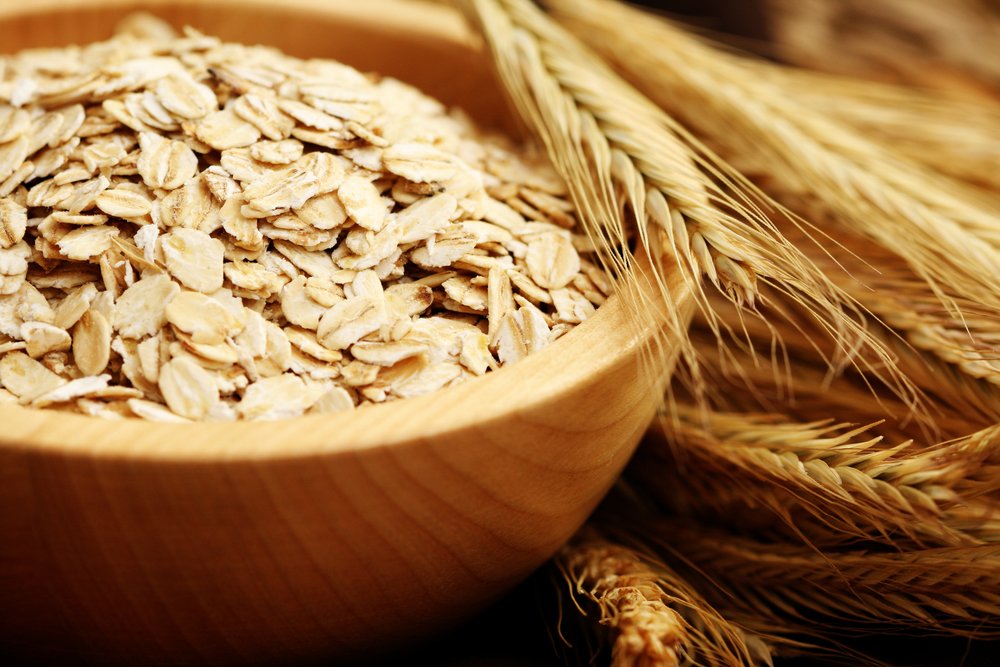
Wheat
US wheat markets closed higher on the week in all three markets. It was a weather market rally as sub-freezing temperatures were reported in the Great Plains and Midwest. There are ideas of potentially significant winterkill in the Great Plains, but not really in the Midwest as the latter crops had snow cover for protection against the cold.
The market faded a bit later in the week as the freeze even passed. However, both the Kansas City and Chicago markets turned trends up on the daily charts and further rallies are possible. Futures are testing important resistance on the weekly charts in Minneapolis. Ideas are that the funds will soon need to cover at least part of a significant short position, and these ideas have helped support the markets at the current time. The market is noting dry conditions in western Kansas and other parts of the western Great Plains and the La Nina Winter weather forecast.
In fact, a drought has developed in the region and could become serious. The crop has not established itself well due to the dry weather. USDA will issue its winter wheat plantings reports along with new supply and demand estimates on Friday. Price Group expects all winter wheat area at only 30.65 million acres. Hard red winter area could be 21.89 million acres and soft red winter area could be 21.89 million acres. Quarterly stocks could be about 1.835 billion bushels, and USDA should leave its ending stocks estimates unchanged at 960 million bushels.
World estimates, in general, remain large and US offers will need to be low to take the business. However, the US prices are in fact low and increased demand is possible. The weekly charts show that both winter wheat markets and Minneapolis spring wheat markets remain in sideways trends. Futures in winter wheat are at low prices not seen in the last decade. Minneapolis prices are holding just above important support areas on the weekly charts.
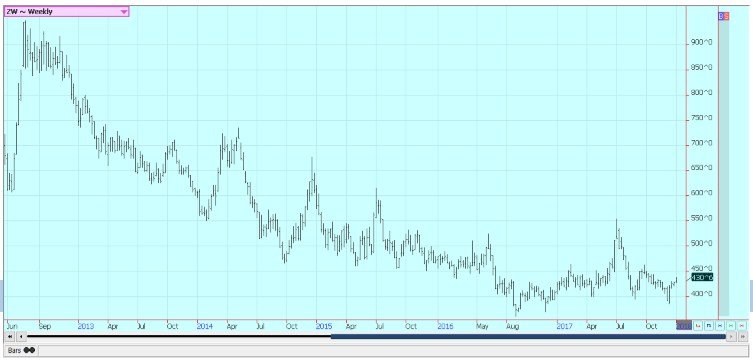
Weekly Chicago Soft Red Winter Wheat Futures © Jack Scoville
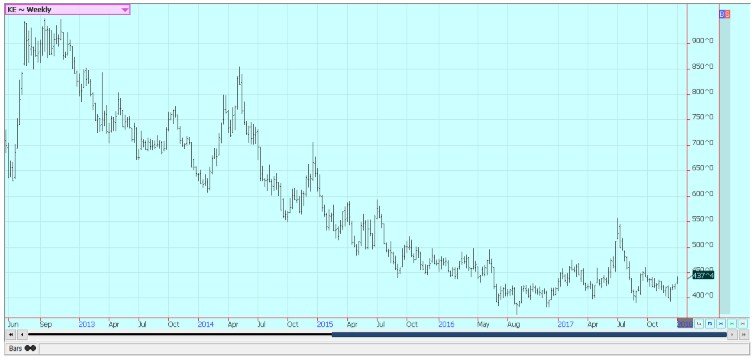
Weekly Chicago Soft Red Winter Wheat Futures © Jack Scoville
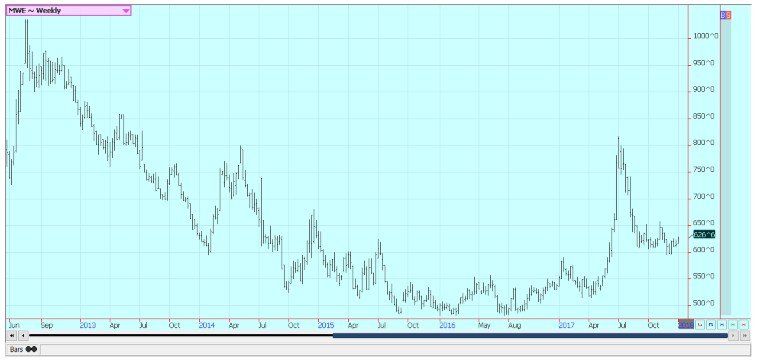
Weekly Minneapolis Hard Red Spring Wheat Futures © Jack Scoville
Corn
Corn and oats closed slightly higher last week and oats show the potential to move higher on the daily charts. A move to 264 in March oats is possible. Some speculative buying was seen in corn as funds and other large speculators continue to hold the record or near record short positions in this market. However, the buying was not as impressive as it could have been as the funds seem to interpret the current fundamental picture as bearish amid weaker holiday demand in the export market and significantly less ethanol demand in the latest reporting week.
Overall demand for corn remains good, and demand for other feed grains such as sorghum and oats is strong. Demand in the US has been very strong from the ethanol sector and USDA will likely need to increase corn consumption from this sector again this month in the supply and demand updates that will be released at the end of this week. It could easily add another 25 million bushels to the demand side of the data. Questions continue about corn demand from the feed sector, but the animals are out there to feed.
Price Group expects USDA to estimate corn production a little lower at 14.453 billion bushels on a yield of 173.9 bushels per acre. Ending stocks should be near 2.263 billion bushels. Quarterly stocks are estimated at 12.345 billion bushels. The trade is still looking at the dry weather in southern Brazil and Argentina. Forecasts for this week are hot and dry again, with the biggest problems in Argentina.
Ideas of big supplies and weaker demand keep pulling the market down fundamentally, and it has been the funds who have established a huge and near record short position in futures. Farmers have reportedly sold some Corn for the end of the year cash and tax considerations. Not much selling is reported in South America. US prices are cheap now and trends in the market are sideways.
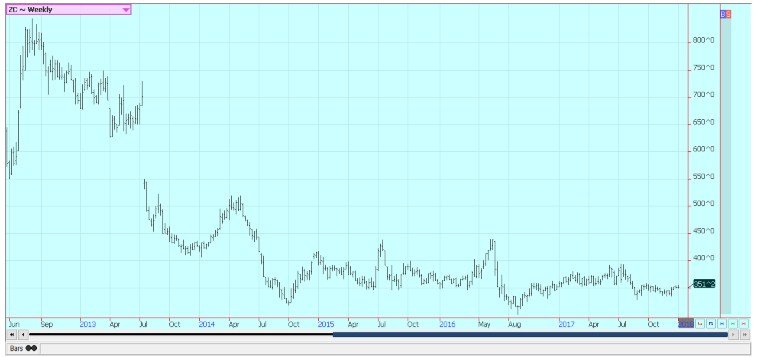
Weekly Corn Futures © Jack Scoville
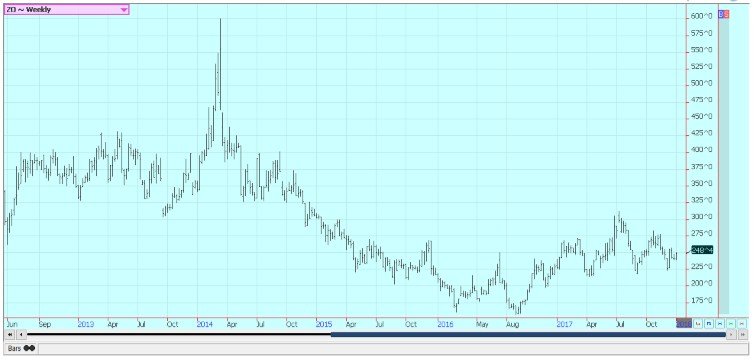
Weekly Oats Futures © Jack Scoville
Soybeans and Soybean Meal
Soybeans and soybean meal were a little higher and continue to find support from the continued reports of drought in far southern Brazil and parts of Argentina. Conditions in both countries are expected to be hot and dry again this week. The trade expects USDAA to make few changes to production estimates for both countries this week as it waits to see how the weather situation works out over the next couple of months. The most important part of the summer growing season for both countries is just underway now.
The fundamental reason for soybeans to work lower was fears of reduced Chinese demand and ideas of improved planting conditions in Brazil and the big production last year in South America that has had Brazil offering for the entire year. Brazil has been able to capture more business that otherwise would have gone to the US due to the huge crop last year.
US prices are good enough and the questions about South American production potential are strong enough that the US is in a good position now to keep exports high well into the Spring. USDA will issue its production and supply and demand estimates on Friday. Price Group expects production near 4.425 billion bushels on an average national yield of 49.5 bushels per acre. Soybeans quarterly stocks are estimated at 3.150 billion bushels and ending stocks are estimated at 470 million bushels.
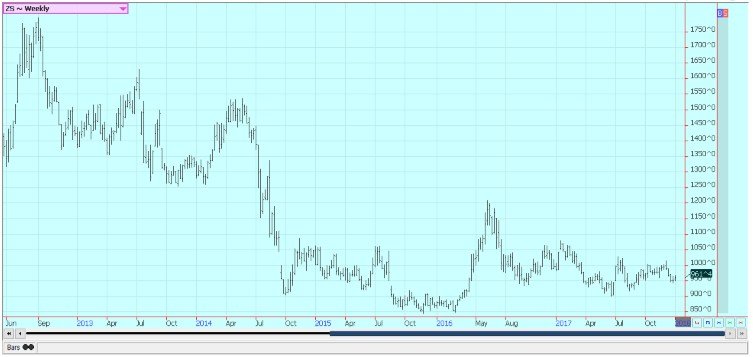
Weekly Chicago Soybeans Futures © Jack Scoville
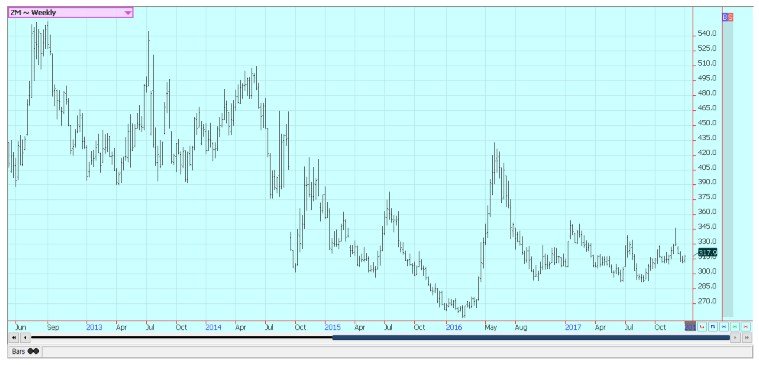
Weekly Chicago Soybean Meal Futures © Jack Scoville
Rice
Rice prices closed higher and trends became more neutral on the charts at the close of the week. Weekly charts still show downtrends. The recovery once again came at the end of the day and took just a few minutes to complete as there was no selling interest seen. The price action from the last couple of days last week would imply that bearish traders have pushed the market to low enough levels and that at least a more two-sided trade can be expected this week.
The cash market remains rather quiet so a further move lower is possible. Futures market fundamentals have not really changed, but traders are leaving the market as the open interest has been dropping. The situation for rice remains somewhat bullish at this time. USDA will issue its latest production and supply and demand reports on Friday. Little overall change is expected in production. Demand has been at least as strong as expected and USDA could increase export demand slightly and reduce ending stocks slightly.
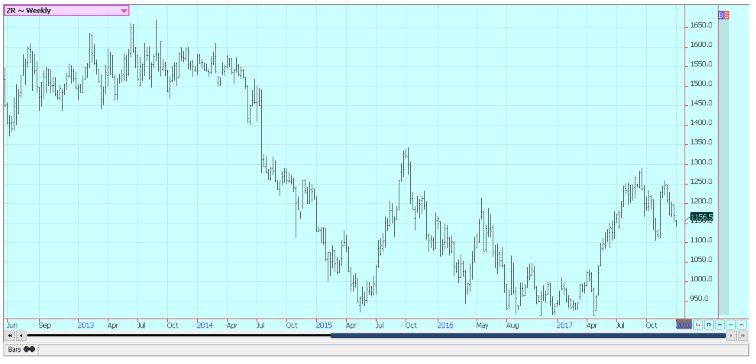
Weekly Chicago Rice Futures © Jack Scoville
Palm Oil and Vegetable Oils
World vegetable oils prices were higher last week, and the price action was very strong in palm oil. Palm oil rallied on stronger than expected export demand in Malaysia as reported by the private sources. There are hopes that the stronger demand can extend into this month. There are still concerns about increased production at this time of year, but it has been the demand news that has operated ion the markets.
Trends in all three futures markets are more sideways now after the big rallies, but all three futures markets are near some resistance areas on the weekly charts and will get data this week from MPOB in palm oil and USDA for the other markets that could say a lot about the direction of the next move. Canola markets have firmed and could turn into a trading affair. It is warmer in the Prairies this week and the harvest is over, so farmers are not as willing to sell. However, deliveries to elevators have been strong due in part to forward selling earlier in the year. US demand for soybean oil in biofuels should remain strong as the US moved to put punitive tariffs on imports from Indonesia and Argentina.
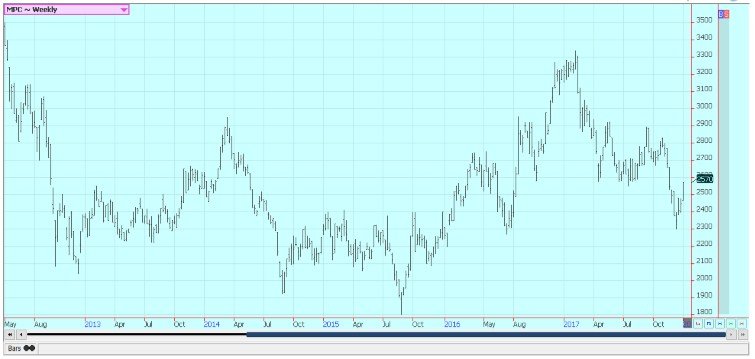
Weekly Malaysian Palm Oil Futures © Jack Scoville
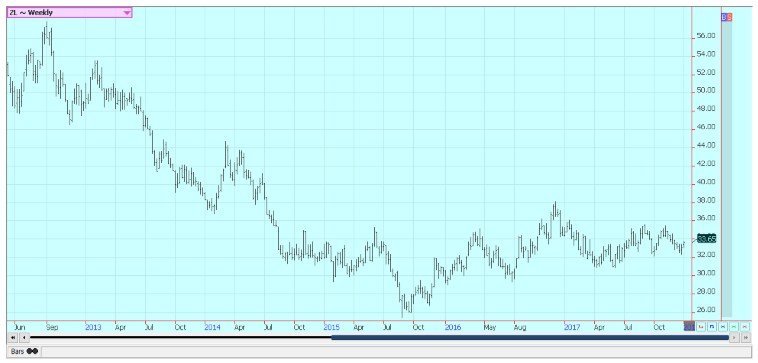
Weekly Chicago Soybean Oil Futures © Jack Scoville
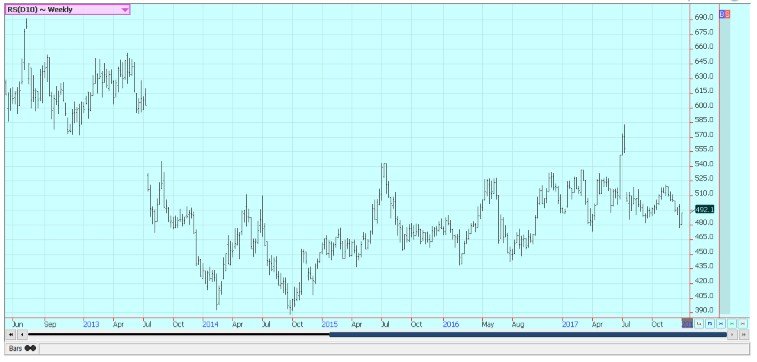
Weekly Canola Futures © Jack Scoville
Cotton
Cotton was higher again last week and nearby months made new contract highs before the market collapsed on Friday in response to a second week of relatively poor export. The cotton quality has been dropping as the harvest is over, and the lower quality seems to be the biggest effects from the hurricanes seen during the growing season and then the freeze in the west at the tail end of the growing season.
Price Group expects few changes to US production estimates as the cotton production appears to have held well. USDA reported that cotton classed is now just over 16.1 million bales. USDA can show increased export demand and slightly smaller ending stocks, although overall supplies should still be big. Some traders say that USDA is seriously underestimating demand for the fiber, while the others look to the high USDA ending stocks estimates and suggest that any demand can be easily met.
The demand bulls are winning the battle of ideas and price right now. Farmers are reported to be quiet sellers right now. Harvest conditions are good in just about all areas. World production seems to be dropping. India announced lower production estimates last week due to some pest problems and uneven rains in some growing areas. Gujarat, in particular, has had its problems, with a dry stretch early and then flooding rains. Now the reports of losses from pests imply that the country will offer less competition for the US in the world market. The US stands in place to do a lot of business this year, so prices overall should stay relatively strong.
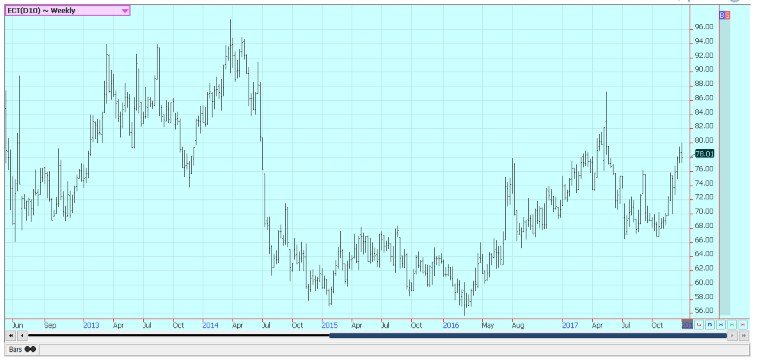
Weekly US Cotton Futures © Jack Scoville
Frozen Concentrated Orange Juice and Citrus
FCOJ closed lower on Friday, but higher for the week as some cold air hit the state of Florida in the first half of the week. Temperatures did not get cold enough to damage crops. The market had given back the gains it had in reaction to the damage caused by Hurricane Irma before bouncing as the overall supply and demand ideas remain negative for the market.
Overall weather conditions are considered good in Florida at this time, with mostly dry and warm conditions after the cold of last week.The cooler temperatures will help with acid production inside the fruit. The harvest is progressing well and fruit is being delivered to processors and the fresh fruit packers. Trees in Florida that are still alive now are showing fruits of good sizes, although many have lost a lot of the fruit.
Florida producers are actively harvesting and performing maintenance on land and trees. Processors are getting packinghouse eliminations along with taking mostly field-run fruit. FCOJ processors are also getting imports from Brazil, Mexico, and Europe. USDA will issue production estimates on Friday and production could once again be a little lower as the crop damage is further understood.
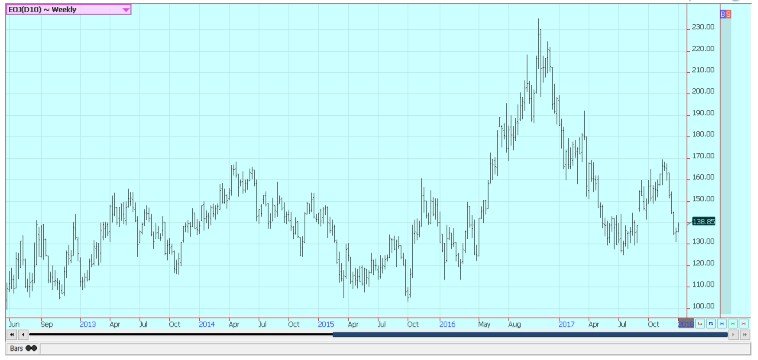
Weekly FCOJ Futures © Jack Scoville
Coffee
Futures were lower in New York and in London for the first part of last week. The funds and other speculators continued to sell with the new downtrend seen on the charts in both markets. The selling started to abate last Wednesday, but little new buying interest was noted.
We were in Vietnam for the last week and saw some farms near the city of Da Lat. Trees were full of fruit and the fruit was turning color. Some harvesting was being seen, and mills were open and producing green coffee. It looked like a good crop was coming in this area from our farm visits. The country is looking to replant trees as has been done in parts of Latin America and knows it must improve quality to get better prices. This effort looks to be the focus of the government and industry for the next few years.
Internal prices in Vietnam remain at high levels compared to London. The situation seems little changed in Latin America. Brazil exports are reduced at about 2.8 million bags on what is called reduced inventories held by exporters and producers. Many are concerned about the potential for reduced Brazil production due to earlier drought and the cold and dry winter, although some exporters suggest that the loss potential has been greatly overestimated. There is plenty of rain in some areas now There are also reports of short crops in parts of Central America and some areas in South America due to the lack of farmer investment from the low prices.
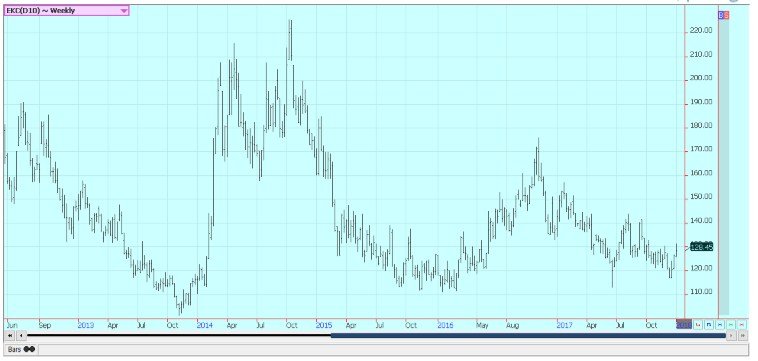
Weekly New York Arabica Coffee Futures © Jack Scoville
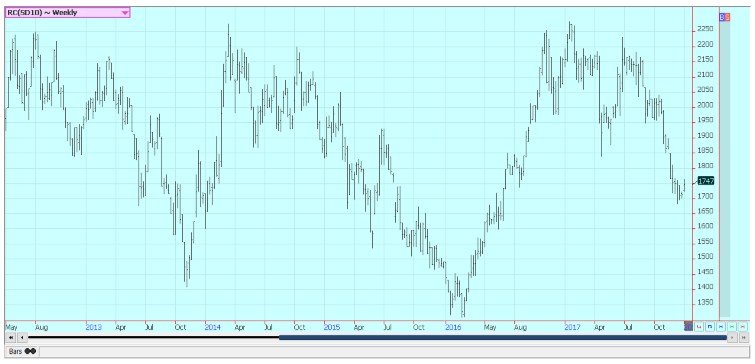
Weekly London Robusta Coffee Futures © Jack Scoville
Sugar
Futures were higher once again last week and New York futures are still close to important resistance areas on the daily and weekly charts. Price action has been strong due to the strong demand for ethanol that has diverted some Brazil mill production away from sugar. Mills in Brazil have decided to make more ethanol as world crude oil and products prices have been very strong. Ideas are that these prices can continue strong as OPEC and Russia have agreed to keep production constrained compared to world demand. There are also ideas that index funds will add significantly to long positions in the rebalancing operations later this month. The rebalancing could cause significant new buying for the market.
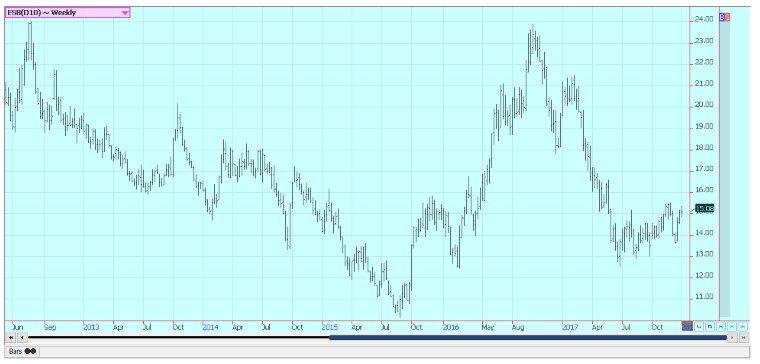
Weekly New York World Raw Sugar Futures © Jack Scoville
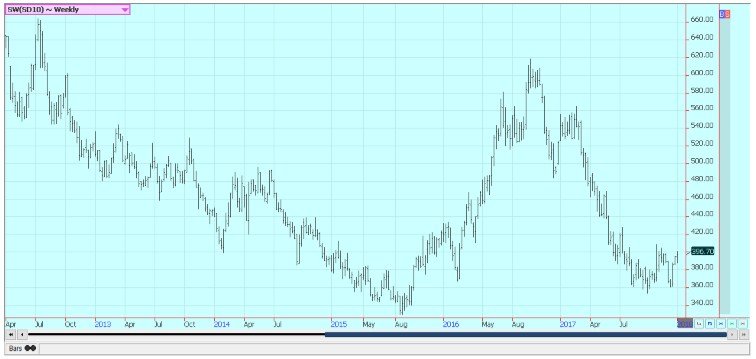
Weekly London White Sugar Futures © Jack Scoville
Cocoa
Futures closed lower slightly higher in New York, but lower in London last week. Trends are sideways in New York and remain down in London for the short term. Weekly charts show that New York might be forming a bottom. Arrivals have been good in West Africa and are reported to be good in Southeast Asia so far this season.
However, arrivals in West Africa have been behind year-ago levels when they were expected to be above year-ago levels. Ghana purchases have been about as expected. Prices are weak overall due to the ongoing harvest but have found some good buying interest at current levels as some are now viewing the market as cheap.
Current prices in New York remain close to lower levels seen for at least five years. World supply ideas remain high. Harvest reports show good production will be seen this year in West Africa. The growing conditions in other parts of the world are generally good. East Africa is getting better rains now. Good conditions are still seen in Southeast Asia and harvest should be strong now amid mostly dry weather.
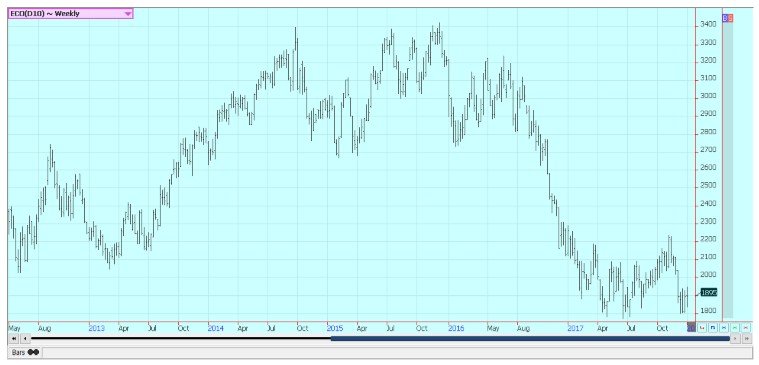
Weekly New York Cocoa Futures © Jack Scoville
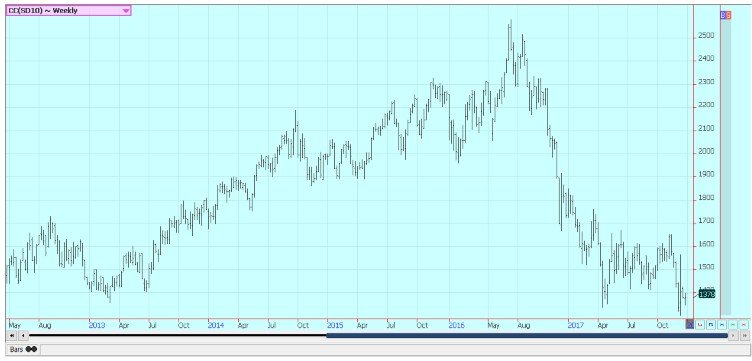
Weekly London Cocoa Futures © Jack Scoville
(Featured image via Deposit Photos)
_
DISCLAIMER: This article expresses my own ideas and opinions. Any information I have shared are from sources that I believe to be reliable and accurate. I did not receive any financial compensation in writing this post, nor do I own any shares in any company I’ve mentioned. I encourage any reader to do their own diligent research first before making any investment decisions.

-

 Crypto1 week ago
Crypto1 week agoRipple in 2025: Legal Victory, RLUSD Growth, and XRP’s Uncertain Future
-

 Crowdfunding3 days ago
Crowdfunding3 days agoCrowdfunding Grants Open for Business Projects Until January 2026
-

 Impact Investing2 weeks ago
Impact Investing2 weeks agoTreeblock Showcases Sustainability Solutions at ADIPEC Abu Dhabi
-

 Impact Investing1 week ago
Impact Investing1 week agoHigh Awareness, Low Adoption: The VSME Challenge for European SMEs


























You must be logged in to post a comment Login